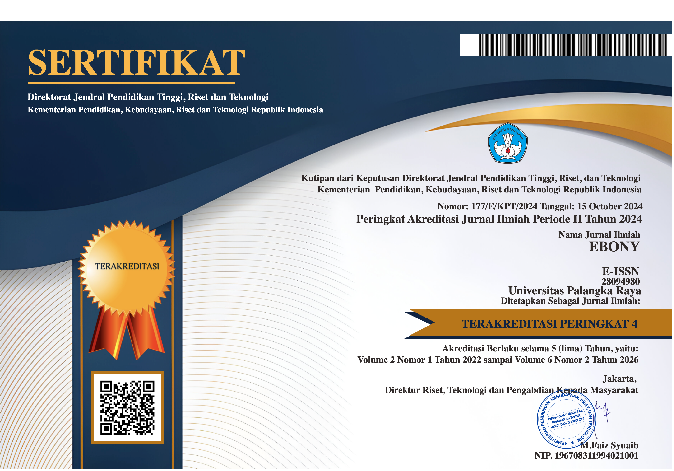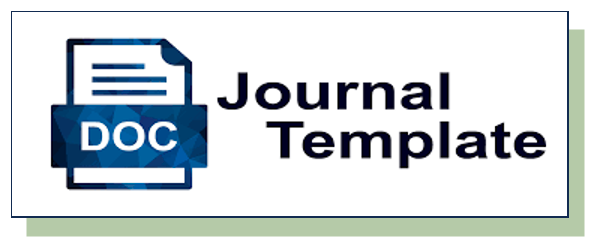The Analysis of Machine Translation Performance on Translating Informative Text from English into Indonesian
DOI:
https://doi.org/10.37304/ebony.v3i2.9809Keywords:
machine translation, performance, informative textAbstract
This study aims to investigate the performance of 6 machine translation. The text translated was informative text from English into Indonesian. The document taken from 48 students paper in semester final test. The research design is descriptive qualitative and content analysis approach. The data obtained from the students translation result in final test, observation, and interview. In analyzing the result of translating, there were three categories: grammatical structure, cultural words, and mechanic writing (composition writing). The result shows the performance of 6 machine translations: Google translate (GT), DeepL, Yandex, Systran, Udictionary, Microsoft translator, and itranslate on grammatical structure analysis were understanable related to meaning because the language is news report in formal language and reporting facts. However, some roles of language were changes such as: tenses, word formation, active/passive, singular plural, article, and auxiliary verbs. There was no example in cultural words and mechanic writing because the form of language is news report. The result of observation indicated that the students already apply technology in translation by utilizing MT in translating text. Furtthermore, in the result of interview implied that the usage of MT can give an assistance in translating text from English into Indonesian especially for informative text.
Downloads
References
Angelina, Y., & Handayani, M. (2020). Students’ Perspective on Using Transtool in Converting English Text to Indonesian. Journal of English Educational Study (JEES), 3(1), 21–30. https://doi.org/10.31932/jees.v3i1.630
Apriyanti, T., Wulandari, H., Safitri, M., & Dewi, N. (2017). Translating Theory of English into Indonesian and Vice-Versa. Indonesian Journal of English Language Studies (IJELS), 2(1), 22. https://doi.org/10.24071/ijels.v2i1.350
Emzir, E., Lustyantie, N., & Akbar, A. (2017). Translation of English Tasks into Indonesian Through Online Machine Translation Program. Ijer - Indonesian Journal of Educational Review, 4(1), 103. https://doi.org/10.21009/ijer.04.01.10
Fitria, T. N. (2021). A Review of Machine Translation Tools: The Translation’s Ability. Language Circle: Journal of Language and Literature, 16(1), 162–176. https://doi.org/10.15294/lc.v16i1.30961
Garg, A., & Agarwal, M. (2018). Machine Translation: A Literature Review. http://arxiv.org/abs/1901.01122
Harto, S., Hamied, F. A., Musthafa, B., & Setyarini, S. (2022). Exploring undergraduate students’ experiences in dealing with post-editing of machine translation. Indonesian Journal of Applied Linguistics, 11(3), 696–707. https://doi.org/10.17509/ijal.v11i3.42825
He, Y. (2021). Challenges and Countermeasures of Translation Teaching in the Era of Artificial Intelligence. Journal of Physics: Conference Series, 1881(2). https://doi.org/10.1088/1742-6596/1881/2/022086
Hutchins, J. (2005). The history of machine translation in a nutshell. Retrieved December, November, 5. http://hutchinsweb.me.uk/Nutshell-2005.pdf
Kolhar, M., & Alameen, A. (2021). Artificial Intelligence Based Language Translation Platform. Intelligent Automation & Soft Computing, 28(1), 1–9. https://doi.org/10.32604/iasc.2021.014995
Kong, L. (2022). Artificial Intelligence-Based Translation Technology in Translation Teaching. Computational Intelligence and Neuroscience, 2022. https://doi.org/10.1155/2022/6016752
Lederer, M. (2003). Translation: The Interpretive Model (N. Larche, Trans.; 1st ed.). Routledge. https://doi.org/10.4324/9781315760315
Long, J. (2013). Translation Definitions in Different Paradigms. Canadian Social Science, 9(4), 107. https://doi.org/10.3968/j.css.1923669720130904.2703
Marito, S., & Ashari, E. (2017). Efl Students’ Perception About Machine Translation. Jurnal Dimensi, 6(2), 256–269. https://doi.org/10.33373/dms.v6i2.1050
Munday, J. (2008). Introducing Translation Studies: Theories and Applications (2nd ed.). Routledge. https://doi.org/10.4324/9780203869734
Ng, A. (2016). What Artificial Intelligence Can and Can’t Do Right Now. Harvard Business Review. https://hbr.org/2016/11/what-artificial-intelligence-can-and-cant-do-right-now
Purwaningsih, D. R. (2016). 678-1365-1-Sm. 01(01), 1–9.
Robinson, D. (2019). Becoming a translator: An introduction to the theory and practice of translation, fourth edition. Becoming a Translator: An Introduction to the Theory and Practice of Translation, Fourth Edition, 1–304. https://doi.org/10.4324/9780429276606
Setiawan, D. (2020). Analysing the Works of a Machine Translation. International Journal of Language and Literary Studies, 2(2), 210–210. https://doi.org/10.36892/ijlls.v2i2.292
Ummami, D. A. (2019). Vivid: Journal of Language and Literature Translation Equivalence in English-Indonesia Text. Vivid: Journal of Language and Literature, 8(2), 35–37. http://dx.doi.org/10.25077/vj.8.2.35-37.2019
Vanjani, M., & Jones, J. H. (2020). A Comparison of Free Online Machine Language Translators. Journal of Management Science and Business Intelligence, 2020, 26–31. https://doi.org/10.5281/zenodo.3961085
Downloads
Published
How to Cite
Issue
Section
License
Copyright (c) 2023 Titik Ismailia

This work is licensed under a Creative Commons Attribution 4.0 International License.











